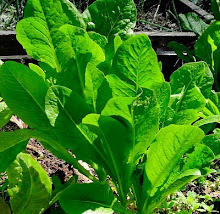By Jane Morse, Environmental Horticulture Extension Agent, and Allen Garner, Florida Yards & Neighborhoods Coordinator, University of Florida Extension - Manatee County.
Rain barrels are a great way to reduce stormwater runoff and to save water for a dry spell. If you have gutters on your house, you may be able to collect 55 gallons of water during a ½ inch rain by directing a downspout to a rain barrel or cistern.
Included below:
- Tools
- Supplies
- Instructions
- Alternate: How to make a rainbarrel from a trash can
This is the left side of the rain barrel (hand-painted by Jennifer Barrineau)
This is the right side of the rain barrel (hand-painted by Jennifer Barrineau)
Drain spigot at bottom of rain barrel
Gutter downspout into top of rain barrel (unscreened)
TOOLS:
• Electric Drill
• Drill bit ½-inch to 1-inch
• Drill bit 3/16-inch
• Drill bit 1/8-inch
• Jigsaw • Marking pen
• Phillips screw driver
• Pocket knife
• Work-bench
• Extension cord
• Safety glasses
SUPPLIES:
Plastic drum (55 gal. is best). Barrels that have carried food products are recommended. Some cleaning product barrels are OK after rinsing. Do NOT use petroleum or toxic chemical barrels.
The following are all PVC fittings:
• Two-inch male adapter
• Two-inch male slip x 3/4-inch female threaded adapter
• 3/4-inch male threaded x 3/4-inch female threaded elbow (3/4 inch street el)
• Four inch long 3/4-inch threaded nipple
The following can be either metal or plastic:
• 3/4-inch female sillcock or hose bibb
• PVC cement
• Teflon™ tape or Teflon™ pipe joint compound
• Silicone sealant
• Three stainless steel sheet metal screws #10 x 3/4 inch
• Stainless steel mesh with plastic rim kitchen strainer (4 to 6 inch diameter)
INSTRUCTIONS:
1. Turn the barrel so that the end with no openings is facing up.
2. Fit the strainer on the end which is facing up so that it lays flat.
3. Mark around the perimeter of the strainer, remove strainer and draw another line about ½ inch inside the perimeter line.
4. Drill a pilot hole using the large bit just inside the inner drawn circle.
5. Using the saber saw follow the inner circle line until the circle is removed. Remove the circle if it has fallen into the barrel. This is a good time to make sure the barrel is clean inside.
6. Drill pilot holes in the strainer flanges and handle using the 3/16-inch bit. Place the strainer on the barrel and mark the hole locations on the barrel.
7. Drill pilot holes in the barrel using the 1/8-inch bit.
8. Partially screw into the strainer the #10 screws. Check to make sure the strainer holes match the barrel holes.
9. Apply silicone sealant to the strainer rim and place the strainer into position. Tighten screws until just snug. (Pat yourself on the back, you have just completed the first part of the barrel).
10. Place the barrel on its side. Unscrew one of the plastic filler plugs in the other end of the barrel.
11. Apply PVC cement to the two-inch male adapter sleeve and place the two-inch male x 3/4-inch female threaded adapter inside and press together for a few seconds.
12. Insert street el into the 3/4-inch hole of the adapter. Use teflon tape or sealant on all threaded parts.
13. Insert 4 inch nipple into street el.
14. Screw assembly into barrel. Four-inch nipple will work as a wrench to tighten first two fittings.
15. Connect water faucet to 4-inch nipple. Hand-tighten to proper position.
16. Place barrel on level, sturdy base. Direct downspout over the strainer. (Hooray, you now have a functioning rain barrel).

Diagram of rain barrel
There are booklets available from from the University of Florida/IFAS Sarasota County Extension office at 6700 Clark Road, Sarasota, FL.
You may view and download the Southwest Florida Water Management Districts Rainbarrel Guide for Homeowners. Click here. (http://sarasota.extension.ufl.edu/FYN/rain_barrels_guide.pdf)
Southwest Florida Water Management also has an excellent page that includes a video. Click here. (http://www.swfwmd.state.fl.us/conservation/rainbarrel/)
HOW TO MAKE A RAINBARREL USING A TRASH CAN
If you are unable to obtain a pickle barrel such as the one shown above, you still have some options. The links below all discuss how to make rain barrels from trashcans.
Rain barrels: Rain barrel made out of a 32 gallon trashcan, soaker hose, two outlet valves, silicon gel and two cinder blocks . Total cost about $12. The rain barrel will water plants about 4~5 days. http://rainbarrels.info/
Trash Cans can be used; however, for the back pressure to occur completely, the top should be sealed with duct tape.
http://www.gardenwatersaver.com/9.html
Plastic trash cans are usually too thin to be good barrels.
http://www.longwood.edu/cleanva/rainbarrels.htm
55-gallon barrel with closed top or 30- to 44-gallon heavy duty plastic trash can.
http://berks.extension.psu.edu/MG/seasadv/rainbarrel.html
VIDEO - How to make a rain water storage barrel from a plastic trash can. Step by step instructions with a complete layout of the few simple parts needed to make a rain barrel.
http://www.revver.com/video/392549/making-a-rain-water-storage-barrel-with-spigot/
Above info thanks to: http://sarasota.extension.ufl.edu/FYN/Rainbarrel.shtml









It’s important to consider the volume of rain in your area before building your barrels. Once the rain starts to pour, the number of barrels you have must be enough to hold the water. Don’t commit the mistake of taking this crucial step for granted. Thank you for creating a comprehensive guide!
ReplyDeleteSharon Strock